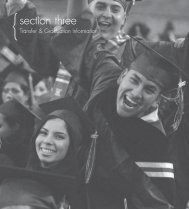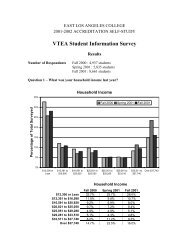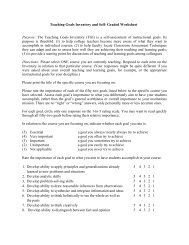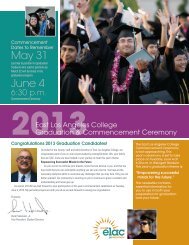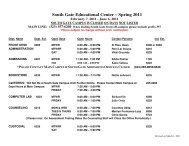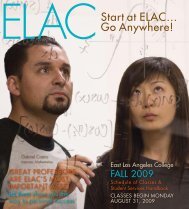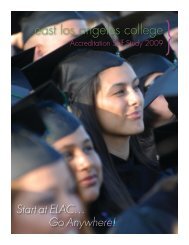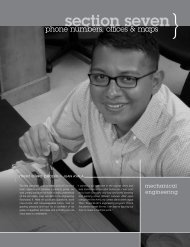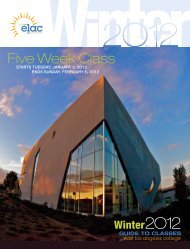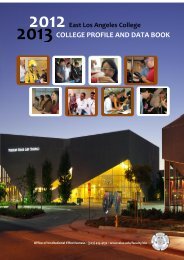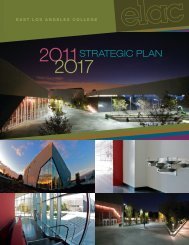The 2011 - 2013 General Catalog - East Los Angeles College
The 2011 - 2013 General Catalog - East Los Angeles College
The 2011 - 2013 General Catalog - East Los Angeles College
You also want an ePaper? Increase the reach of your titles
YUMPU automatically turns print PDFs into web optimized ePapers that Google loves.
<strong>General</strong> Information<br />
<strong>General</strong> Information<br />
<strong>General</strong><br />
Information<br />
History<br />
Campus Founded<br />
<strong>East</strong> <strong>Los</strong> <strong>Angeles</strong> Junior <strong>College</strong> was established in June 1945 by the<br />
<strong>Los</strong> <strong>Angeles</strong> City Board of Education. <strong>The</strong> <strong>College</strong> opened its doors<br />
for the fall 1945 semester in September in a wing of Garfield High<br />
School boasting 19 faculty members and 117 students, many of whom<br />
were World War II veterans.<br />
<strong>The</strong> <strong>College</strong> quickly outgrew the borrowed high school facilities. In<br />
1947, the Board of Education was able to purchase 82 acres of agricultural<br />
land in what was then <strong>East</strong> <strong>Los</strong> <strong>Angeles</strong>, thanks to funding<br />
from a bond issue. Two years later in January 1949, classes began<br />
at the <strong>College</strong>’s present location in wooden bungalows moved to the<br />
campus from the Santa Ana Army Base. More than 1700 students<br />
enrolled that year.<br />
An evening program that began in 1947 was expanded and offered<br />
at many locations. By 1954, the popular program offered classes at<br />
25 different locations. <strong>The</strong> Civic Center program alone enrolled over<br />
1,900 students that year.<br />
In 1948 a name change was proposed. <strong>Angeles</strong> Bella Vista <strong>College</strong>,<br />
Ramona Hills <strong>College</strong> and Hillview <strong>College</strong> were considered. <strong>The</strong> following<br />
year “Junior” was dropped and the name <strong>East</strong> <strong>Los</strong> <strong>Angeles</strong><br />
<strong>College</strong> (ELAC) was firmly established.<br />
Permanent buildings were constructed to accommodate growing<br />
enrollment. In 1951 the stadium and auditorium were built. More<br />
classrooms, an administration building, a library, a planetarium,<br />
men’s and women’s gyms, a swim stadium, a theater, and an art gallery<br />
followed.<br />
Community Support and Enrollment Growth<br />
Today’s Vincent Price Art Museum began with a gift from Vincent<br />
Price —noted actor and art collector—who donated 90 pieces from<br />
his collection to establish the first “teaching art collection” in 1957.<br />
Over the years, the collection has grown to more than 8,000 pieces<br />
including works on paper, paintings and three-dimensional art work.<br />
This collection provides an extraordinary and unique resource for students<br />
to see original art firsthand to reinforce lectures in art history<br />
and art appreciation.<br />
During the 1960s and 1970s, buildings were added to campus to<br />
house the nursing program, a new library and later the automobile<br />
technology center. Many of the original bungalows were still used as<br />
classrooms until 2007 when they were finally demolished to make way<br />
for new campus structures.<br />
In 1969 the California State Legislature clearly defined higher education<br />
in the state and designated the (then) eight community colleges<br />
of the <strong>Los</strong> <strong>Angeles</strong> Unified School District as the <strong>Los</strong> <strong>Angeles</strong> Community<br />
<strong>College</strong> District (LACCD). A seven-member Board of Trustees<br />
was elected to govern the new district. Today, the ELAC service<br />
area, home to more than 1.5 million people, includes the communities<br />
of Alhambra, Bell, Bell Gardens, City of Commerce, Cudahy, <strong>East</strong><br />
<strong>Los</strong> <strong>Angeles</strong>, Huntington Park, <strong>Los</strong> <strong>Angeles</strong>, Maywood, Montebello,<br />
Monterey Park, Rosemead, San Gabriel, South San Gabriel, South<br />
Gate and Vernon.<br />
In 1972 the City of Monterey Park annexed the <strong>College</strong> and surrounding<br />
neighborhood, officially changing the main campus address.<br />
ELAC began growing, adding faculty members, programs and classes<br />
as demand for higher education increased.<br />
During the 1984 Olympic Summer Games, ELAC hosted swimming<br />
and field hockey events, welcoming thousands of spectators to campus<br />
and increasing the international visibility of the <strong>College</strong>. Despite<br />
funding challenges that limited growth during the 1980s, ELAC continued<br />
to offer a variety of vocational and transfer programs.<br />
Campus Transformation<br />
During the 1990s ELAC experienced unprecedented growth and<br />
change. Enrollment grew from 13,000 to approximately 30,000 students<br />
and the number of permanent faculty almost doubled. Outreach<br />
programs were located throughout the service area for the convenience<br />
of students who could not easily travel to the main campus. In August,<br />
1997 the full-service South Gate Educational Center was established<br />
in the southern part of the service area so that students could complete<br />
a transfer program and several career programs without attending the<br />
main campus. In 2007, a third site was opened in Rosemead to serve<br />
students in the northeastern portion of ELAC’s service area.<br />
Growth during the first decade of the 21st century was not limited<br />
to increasing enrollment. An emphasis on student- centered education<br />
and providing support that engendered student success increased<br />
ELAC’s graduation numbers. Between 2000 and 2005, <strong>East</strong> <strong>Los</strong> <strong>Angeles</strong><br />
<strong>College</strong> graduated the highest number of Latinos in California.<br />
In 2000, two bond issues, Propositions A and A/AS, initiated by the<br />
LACCD, were approved by voters. Funding of over $281 million<br />
allowed ELAC to begin the most ambitious building program in its<br />
history to substantially improve the <strong>College</strong>’s infrastructure. In the fall<br />
of 2004, a state-of-the-art technology building opened that was started<br />
with state funds and completed with bond money. <strong>The</strong> Technology<br />
Building was the first of many buildings and improvements that are<br />
planned or under construction. By the spring of <strong>2011</strong>, after almost a<br />
decade of planning and construction, more than 240,000 square feet<br />
of classroom, student services and administrative space were added to<br />
the <strong>College</strong> facilities. In addition to buildings, a 1,800 space parking<br />
structure was constructed to provide access to the heart of the campus.<br />
<strong>The</strong> Baum Center, located on the east side of the <strong>College</strong>’s new entry<br />
plaza, was remodeled to be a comprehensive facility for administrative<br />
services complete with a five-room faculty Conference center. Across<br />
the entry plaza is the newly completed Student Services Center that<br />
houses admissions, testing, counseling and financial services under one<br />
roof to maximize student access to enrollment services.<br />
<strong>The</strong> Visual and Performing Arts Center, a $65 million, three-building<br />
complex located at the eastern gateway to the campus, is anchored<br />
by a 77,000 sq. ft. two-story building that is now home to the Dance,<br />
Music and Visual Arts disciplines. <strong>The</strong> <strong>The</strong>ater Department is housed<br />
separately in a two-story building that includes a traditional proscenium<br />
stage theater and a flexible black box performing space. <strong>The</strong><br />
facility also includes workshops for costuming and stage design as well<br />
as classrooms to allow for instruction to occur simultaneously with<br />
performance preparation. <strong>The</strong> Vincent Price Art Museum, the third<br />
building in the center, is equipped with seven galleries, the Thomas<br />
14<br />
east los angeles college




